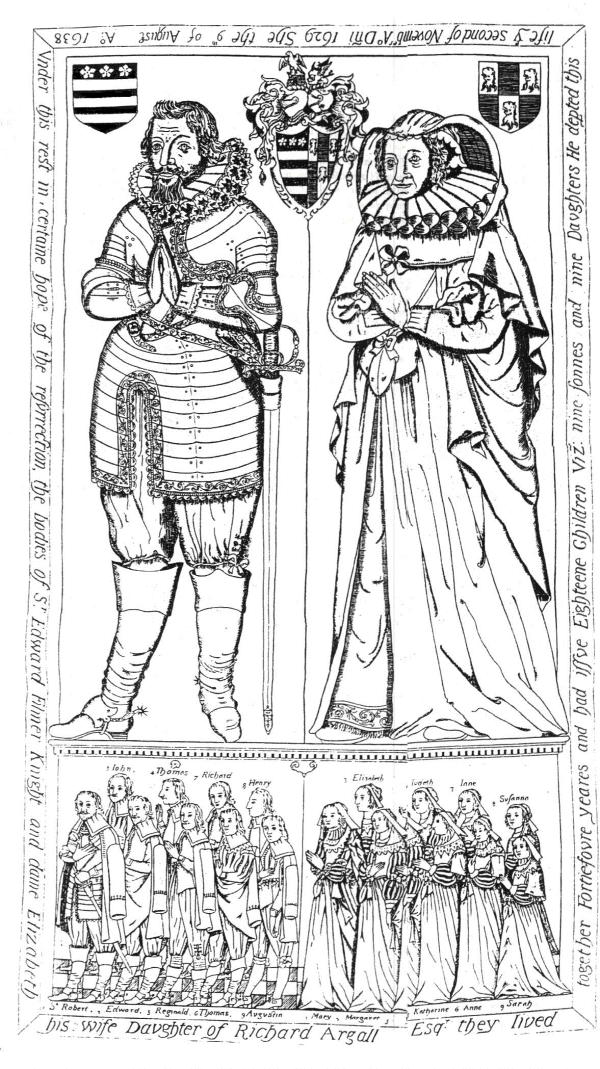Sir Edward Filmer and Lady Elizabeth Argall
and their children on their Brass in Kent, England.

Sir Edward Filmer and Lady
A. D. 1638
"This Brass.... the latest example of any importance in the seventeenth century, was executed between the years 1629 and 1638, and consists of a large sheet of metal upon which are engraven the figures of Sir Edward Filmer of East Sutton, knight, his wife, and their children. The workmanship in general, and the ornamentation in particular, is remarkably similar to the Brass of Archbishop Harsnett 1631, and, like that, is probably of foreign manufacture.
The Filmer family was originally seated at Herst, in the parish of Otterden, Kent, where Robert Filmer lived in the reign of Edward II. Sir Edward Filmer was eldest son of Robert Filmour, prothonotary of the court of Common Pleas in the reign of Queen Elizabeth, who removed to the estate of Little Charleton, in East Sutton, which he had purchased, and died in 1585. Sir Edward increased this estate by purchasing from his brother-in-law John Argall, Esq., the manor of East Sutton; he was knighted by Queen Elizabeth, and served the office of sheriff of Kent 13 James I.
He is represented in a handsome suit of body armor, a large frill round his neck, trunk-breeches, and jack-boots. His wife, Elizabeth, daughter of Richard Argall, esq., wears a cap, hood, ruff and short mantle; her dress opens in front and discovers a petticoat worked and fringed at the edge. Upon the death of this lady, Lovelace penned an elegant "Elegiacal epitaph," which concludes with these lines:--
"Thus, although this marble must,
as all things, must crumble into dust;
and though you find this fair-built tomb
Ashes as what lies in its womb;
Yet her saint-like name shall shine
A living glory in this shrine,
And her eternal fame be read,
When all but very virtue is dead."
Robert, their oldest son, the first of the group below, employed his pen in defense of the crown, was knighted by Charles I., and suffered heavily in purse and person during the civil wars. The inscription round the verge of the plate shows that the monument was prepared in the life-time of the widow, the date of her death having been scratched upon the metal, subsequently to its being placed in the church:
Under this rest in certain hope of the resurrection, the bodies of Sir Edward Filmer, Knight, and dame Elizabeth, his wife, daughter of Richard Argall, Esquire. They lived together forty-four years and had issue eighteen children, Viz: nine sons and nine daughters. He departed this life on the second of November 1629 A. D. She the [9th of August] 16[38] A. D."
Taken from Monumental Brasses from the 13th to the 16th century by John Green Waller & Lionel A. B. Waller, 1864. Reprinted 1975 by Cambridge University.
![]()
![]()
Return to Home Page![]()
Contact June
Shaputis at june@webpanda.com or jshaputis@hotmail.com
or June Ryan at sioux@starband.net
for corrections or additions.
designed by webpanda.com